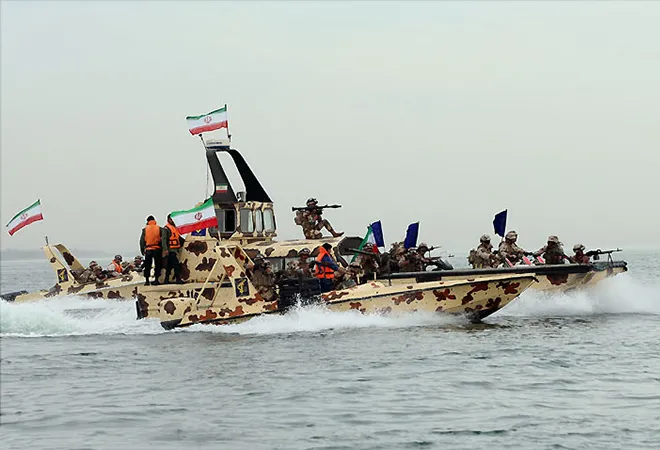-
CENTRES
Progammes & Centres
Location
The threat posed by Iran’s Revolutionary Guards Navy to the Strait of Hormuz is real, but exaggerated. Its advantages in open, asymmetric warfare would dissipate in an extended conflict with a technologically superior adversary.

The United States and Iran seem to be inching closer to war. Days after Washington dispatched an aircraft carrier and B-52 bombers to the Middle East to deter what it deemed threats from Tehran, four ships — two Saudi Arabian tankers and one each from the UAE and the Netherlands — were damaged in an alleged attack by Iranian forces in the Persian Gulf last week. Tehran is also accused of targeting Saudi and UAE facilities that bypass the Strait of Hormuz, a narrow waterway through which one-fifth of the world’s oil supply passes.
One reason Iran is a prime suspect in these cases of alleged sabotage is because its leaders have been threatening to close down the Persian Gulf. Last month, the Iranian chief of army staff warned that Tehran would act if “hostilities with the US reach a level where closure of the vital Strait of Hormuz could not be avoided.” Major General Mohammad Baqeri said that while Tehran did not “intend” to shut down the Strait of Hormuz, it would do so “if Iranian oil was not allowed to pass.” Soon, Washington announced that it would be reviewing its military strategy against Iran drawing up plans to send as many as 120,000 troops to the Middle East, should Tehran order attacks against American forces or accelerate work on nuclear weapons.
Expectedly, attention in Washington has focused on Iranian military movements in the Gulf region. US intelligence agencies say they have evidence anti-ship cruise missiles were placed on boats belonging possibly to the naval branch of the Revolutionary Guard (IRGC) — Iran’s dreaded militia force that the US designated a terrorist organisation last month. Unlike the Islamic Republic of Iran Navy (IRIN) that performs a traditional security role, the IRGC Navy uses ‘swarm’ tactics to harass and intimidate opponents in the Persian Gulf. Its cadres have a clear brief: control Iran’s near-seas though a constant show of strength; if pushed hard, attack in packs to overwhelm enemy defenses.
The threat posed by the revolutionary guards’ navy is amplified by the peculiar maritime geography of the region. At just under 22 nautical miles wide at its narrowest point, the Strait of Hormuz is not hard to sabotage. A single constricted entry point renders the space conducive to offensive denial operations, and the short distances involved make naval operations less surveillance and technology intensive. The region’s geography compresses the warning time available to an enemy defending against missile strikes; its noisy coastal waters create an ideal acoustic environment for submarine operations.
While closing the Strait of Hormuz would be a possible last resort for Iran — perhaps in response to preemptive US strikes or an attack on critical Iranian capabilities — growing political and economic pressure could force the Iranian regime to opt for extreme measures. If Tehran were to give its forces a go-ahead, its preferred mode of sabotage would probably be sea-mines. Iranian forces have a particular expertise in sea mining, and since the ‘Tanker Wars’ in the early-1980s, and it has since remained an intrinsic part Iran’s naval strategy in the Persian Gulf.
Yet, the decision to close down Strait of Hormuz isn’t going to be an easy one for Tehran. With 93% of Iran’s total exports and 83% imports are conducted via sea, Iranian policymakers are aware of the huge risks it would pose to their country’s own shipping. Conceivably, the Iranian leadership might instruct the IRGC navy to spare a narrow strip to enable Iranian traffic to pass safely, but the latter might not be able to prevent its use by others.
Even from a tactical perspective there are complications. In the past, the Iranian navy has had problems recovering mines, owing largely to the strong currents in the Strait of Hormuz. Iran’s vintage sea mines have also caused accidental explosions, including one last year when mines laid by Iran-backed Houthi rebels off the coast of Yemen killed five fishermen. While Iran’s newer mines are reportedly more sophisticated influence varieties (acoustic, magnetic, pressure and rocket-propelled), it is unclear if they are any safer.
Coordinating mine-laying in the Strait with revolutionary guards’ boats swarm operations might pose another difficulty for Iranian forces. As US naval assets move to sanitise the theatre of action before commencing mine-hunting operations, IRGC navy boats and shore-based missile systems would face a barrage of American fire. The losses would be too many for Tehran to bear.
Against all odds, if Iran’s revolutionary guards did manage to mine critical spaces inside the Persian Gulf, the endeavour won’t be likely be as effective as Tehran expects. The USN’s new unmanned mine hunting systems deployed aboard littoral combat ships are vastly more efficient than older Avenger-class minesweeping ships and Sea Dragon helicopters. With the US Fifth Fleet’s mine countermeasure systems in operation, Iranian planners might find the Strait cleared of mines earlier than they had anticipated.
There is also the possibility of Iranian missile and drone boat attacks in the Persian Gulf. In recent months, Iranian Houthi rebels have staged several — mostly unsuccessful — missile attacks on American and Emeriti naval vessels surface. Some attacks have involved high-speed drone boats packed with explosives, such as a strike on a Saudi frigate in 2017 that killed two sailors. Even so, US close-in-weapons systems and state-of-the-art sensors have helped foil many rebel attacks at sea.
None of this means that Iran's warnings should not be taken seriously. The Islamic Republic does have the capability to challenge US naval forces and the ability to close the Strait of Hormuz, even if only for a limited period. Yet Iran’s advantage in limited, asymmetrical attacks might fast dissipate in an open and extended conflict with a technologically superior adversary.
Many regional states, including India — that has recently reduced its oil imports from Iran — have been watching developments with a growing sense of unease. An Iran-US conflict, especially one involving Iranian attempts to close the Strait of Hormuz has the potential to devastate the global economy. Before Tehran orders its final, kamikaze act and Washington responds with its own strikes, regional policymakers and observers are hoping good sense prevails on both sides.
The views expressed above belong to the author(s). ORF research and analyses now available on Telegram! Click here to access our curated content — blogs, longforms and interviews.

A former naval officer Abhijit Singh Visiting Fellow at ORF. A maritime professional with specialist and command experience in front-line Indian naval ships he has been ...
Read More +